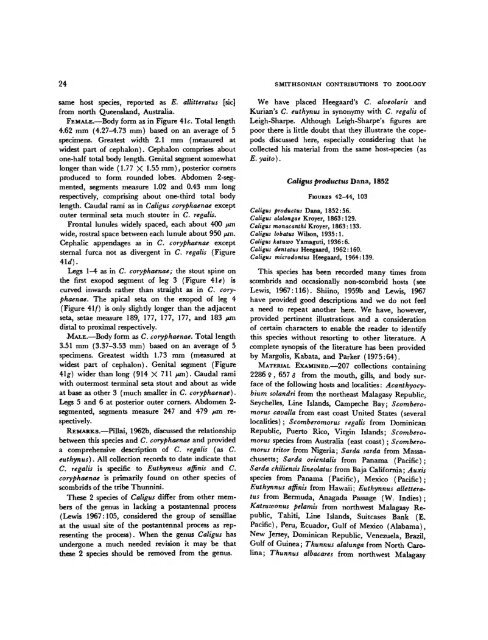Parasitic Copepods of Mackerel - and Tuna-like Fishes (Scombridae ...
Parasitic Copepods of Mackerel - and Tuna-like Fishes (Scombridae ...
Parasitic Copepods of Mackerel - and Tuna-like Fishes (Scombridae ...
Create successful ePaper yourself
Turn your PDF publications into a flip-book with our unique Google optimized e-Paper software.
24 SMITHSONIAN CONTRIBUTIONS TO ZOOLOGY<br />
same host species, reported as E. allitteratus [sic]<br />
from north Queensl<strong>and</strong>, Australia.<br />
FEMALE.—Body form as in Figure 41c. Total length<br />
4.62 mm (4.27-4.73 mm) based on an average <strong>of</strong> 5<br />
specimens. Greatest width 2.1 mm (measured at<br />
widest part <strong>of</strong> cephalon). Cephalon comprises about<br />
one-half total body length. Genital segment somewhat<br />
longer than wide (1.77 X 1.55 mm), posterior corners<br />
produced to form rounded lobes. Abdomen 2-segmented,<br />
segments measure 1.02 <strong>and</strong> 0.43 mm long<br />
respectively, comprising about one-third total body<br />
length. Caudal rami as in Caligus coryphaenae except<br />
outer terminal seta much stouter in C. regalis.<br />
Frontal lunules widely spaced, each about 400 /*m<br />
wide, rostral space between each lunule about 950 /xrn.<br />
Cephalic appendages as in C. coryphaenae except<br />
sternal furca not as divergent in C. regalis (Figure<br />
Legs 1-4 as in C. coryphaenae; the stout spine on<br />
the first exopod segment <strong>of</strong> leg 3 (Figure 41«) is<br />
curved inwards rather than straight as in C. coryphaenae.<br />
The apical seta on the exopod <strong>of</strong> leg 4<br />
(Figure 41/) is only slightly longer than the adjacent<br />
seta, setae measure 189, 177, 177, 177, <strong>and</strong> 183 /*m<br />
distal to proximal respectively.<br />
MALE.—Body form as C. coryphaenae. Total length<br />
3.51 mm (3.37-3.53 mm) based on an average <strong>of</strong> 5<br />
specimens. Greatest width 1.73 mm (measured at<br />
widest part <strong>of</strong> cephalon). Genital segment (Figure<br />
41g) wider than long (914 X 711 /un). Caudal rami<br />
with outermost terminal seta stout <strong>and</strong> about as wide<br />
at base as other 3 (much smaller in C. coryphaenae).<br />
Legs 5 <strong>and</strong> 6 at posterior outer corners. Abdomen 2segmented,<br />
segments measure 247 <strong>and</strong> 479 /tin respectively.<br />
REMARKS.—Pillai, 1962b, discussed the relationship<br />
between this species <strong>and</strong> C. coryphaenae <strong>and</strong> provided<br />
a comprehensive description <strong>of</strong> C. regalis (as C.<br />
euthynus). All collection records to date indicate that<br />
C. regalis is specific to Euthynnus affinis <strong>and</strong> C.<br />
coryphaenae is primarily found on other species <strong>of</strong><br />
scombrids <strong>of</strong> the tribe Thunnini.<br />
These 2 species <strong>of</strong> Caligus differ from other members<br />
<strong>of</strong> the genus in lacking a postantennal process<br />
(Lewis 1967:105, considered the group <strong>of</strong> sensillae<br />
at the usual site <strong>of</strong> the postantennal process as representing<br />
the process). When the genus Caligus has<br />
undergone a much needed revision it may be that<br />
these 2 species should be removed from the genus.<br />
We have placed Heegaard's C. alveolaris <strong>and</strong><br />
Kurian's C. euthynus in synonymy with C. regalis <strong>of</strong><br />
Leigh-Sharpe. Although Leigh-Sharpe's figures are<br />
poor there is little doubt that they illustrate the copepods<br />
discussed here, especially considering that he<br />
collected his material from the same host-species (as<br />
E. yaito).<br />
Caligus productus Dana, 1852<br />
FIGURES 42-44, 103<br />
Caligus productus Dana, 1852:56.<br />
Caligus alalongae Kroyer, 1863:129.<br />
Caligus monacanthi Kroyer, 1863:133.<br />
Caligus lobatus Wilson, 1935:1.<br />
Caligus katuwo Yamaguti, 1936:6.<br />
Caligus dentatus Heegaard, 1962:160.<br />
Caligus microdontus Heegaard, 1964:139.<br />
This species has been recorded many times from<br />
scombrids <strong>and</strong> occasionally non-scombrid hosts (see<br />
Lewis, 1967:116). Shiino, 1959b <strong>and</strong> Lewis, 1967<br />
have provided good descriptions <strong>and</strong> we do not feel<br />
a need to repeat another here. We have, however,<br />
provided pertinent illustrations <strong>and</strong> a consideration<br />
<strong>of</strong> certain characters to enable the reader to identify<br />
this species without resorting to other literature. A<br />
complete synopsis <strong>of</strong> the literature has been provided<br />
by Margolis, Kabata, <strong>and</strong> Parker (1975:64).<br />
MATERIAL EXAMINED.—207 collections containing<br />
2286 9 , 657

















